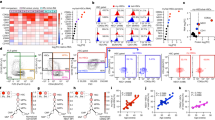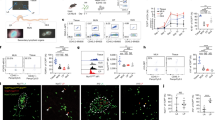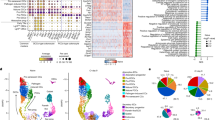Abstract
Although tissue-resident memory T cells (TRM cells) are critical in fighting infection, their fate after local pathogen re-encounter is unknown. Here we found that skin TRM cells engaged virus-infected cells, proliferated in situ in response to local antigen encounter and did not migrate out of the epidermis, where they exclusively reside. As a consequence, secondary TRM cells formed from pre-existing TRM cells, as well as from precursors recruited from the circulation. Newly recruited antigen-specific or bystander TRM cells were generated in the skin without displacement of the pre-existing TRM cell pool. Thus, pre-existing skin TRM cell populations are not displaced after subsequent infections, which enables multiple TRM cell specificities to be stably maintained within the tissue.
This is a preview of subscription content, access via your institution
Access options
Access Nature and 54 other Nature Portfolio journals
Get Nature+, our best-value online-access subscription
$29.99 / 30 days
cancel any time
Subscribe to this journal
Receive 12 print issues and online access
$209.00 per year
only $17.42 per issue
Buy this article
- Purchase on Springer Link
- Instant access to full article PDF
Prices may be subject to local taxes which are calculated during checkout






Similar content being viewed by others
References
Mueller, S. N. & Mackay, L. K.Tissue-resident memory T cells: local specialists in immune defence. Nat. Rev. Immunol.16, 79–89(2016).
Park, C. O. & Kupper, T. S. The emerging role of resident memory T cells in protective immunity and inflammatory disease. Nat. Med. 21, 688–697 (2015).
Casey, K. A. et al. Antigen-independent differentiation and maintenance of effector-like resident memory T cells in tissues. J. Immunol. 188, 4866–4875 (2012).
Steinert, E. M. et al. Quantifying memory CD8 T cells reveals regionalization of immunosurveillance. Cell 161, 737–749 (2015).
Sathaliyawala, T. et al. Distribution and compartmentalization of human circulating and tissue-resident memory T cell subsets. Immunity 38, 187–197 (2013).
Mackay, L. K. et al. The developmental pathway for CD103+CD8+ tissue-resident memory T cells of skin. Nat. Immunol. 14, 1294–1301 (2013).
Mackay, L. K. et al. Hobit and Blimp1 instruct a universal transcriptional program of tissue residency in lymphocytes. Science 352, 459–463 (2016).
Wakim, L. M. et al. The molecular signature of tissue resident memory CD8 T cells isolated from the brain. J. Immunol. 189, 3462–3471 (2012).
Hombrink, P. et al. Programs for the persistence, vigilance and control of human CD8+ lung-resident memory T cells. Nat. Immunol. 17, 1467–1478 (2016).
Ariotti, S. et al. Skin-resident memory CD8+ T cells trigger a state of tissue-wide pathogen alert. Science 346, 101–105 (2014).
Schenkel, J. M. et al. Resident memory CD8 T cells trigger protective innate and adaptive immune responses. Science 346, 98–101 (2014).
Schenkel, J. M., Fraser, K. A., Vezys, V. & Masopust, D. Sensing and alarm function of resident memory CD8+ T cells. Nat. Immunol. 14, 509–513 (2013).
Zaid, A. et al. Persistence of skin-resident memory T cells within an epidermal niche. Proc. Natl. Acad. Sci. USA 111, 5307–5312 (2014).
Ariotti, S. et al. Tissue-resident memory CD8+ T cells continuously patrol skin epithelia to quickly recognize local antigen. Proc. Natl. Acad. Sci. USA 109, 19739–19744 (2012).
Gebhardt, T. et al. Memory T cells in nonlymphoid tissue that provide enhanced local immunity during infection with herpes simplex virus. Nat. Immunol. 10, 524–530 (2009).
Pan, Y. et al. Survival of tissue-resident memory T cells requires exogenous lipid uptake and metabolism. Nature 543, 252–256 (2017).
Simmons, A. & Nash, A. A. Zosteriform spread of herpes simplex virus as a model of recrudescence and its use to investigate the role of immune cells in prevention of recurrent disease. J. Virol. 52, 816–821 (1984).
Shin, H. & Iwasaki, A. A vaccine strategy that protects against genital herpes by establishing local memory T cells. Nature 491, 463–467 (2012).
Mackay, L. K. et al. Long-lived epithelial immunity by tissue-resident memory T (TRM) cells in the absence of persisting local antigen presentation. Proc. Natl. Acad. Sci. USA 109, 7037–7042 (2012).
Mackay, L. K. et al. T-box transcription factors combine with the cytokines TGF-β and IL-15 to control tissue-resident memory T cell fate. Immunity 43, 1101–1111 (2015).
Jiang, X. et al. Skin infection generates non-migratory memory CD8+ TRM cells providing global skin immunity. Nature 483, 227–231 (2012).
Wu, T. et al. Lung-resident memory CD8 T cells (TRM) are indispensable for optimal cross-protection against pulmonary virus infection. J. Leukoc. Biol. 95, 215–224 (2014).
Zens, K. D., Chen, J. K. & Farber, D. L. Vaccine-generated lung tissue-resident memory T cells provide heterosubtypic protection to influenza infection. JCI Insight 1, e85832 (2016).
Gebhardt, T. et al. Different patterns of peripheral migration by memory CD4+ and CD8+ T cells. Nature 477, 216–219 (2011).
Zaid, A. et al. Chemokine receptor-dependent control of skin tissue-resident memory T cell formation. J. Immunol. 199, 2451–2459 (2017).
Russell, T. A., Stefanovic, T. & Tscharke, D. C. Engineering herpes simplex viruses by infection-transfection methods including recombination site targeting by CRISPR/Cas9 nucleases. J. Virol. Methods 213, 18–25 (2015).
Tomura, M. et al. Monitoring cellular movement in vivo with photoconvertible fluorescence protein “Kaede” transgenic mice. Proc. Natl. Acad. Sci. USA 105, 10871–10876 (2008).
Attanasio, J. & Wherry, E. J. Costimulatory and coinhibitory receptor pathways in infectious disease. Immunity 44, 1052–1068 (2016).
Khan, T. N., Mooster, J. L., Kilgore, A. M., Osborn, J. F. & Nolz, J. C. Local antigen in nonlymphoid tissue promotes resident memory CD8+ T cell formation during viral infection. J. Exp. Med. 213, 951–966 (2016).
Muschaweckh, A. et al. Antigen-dependent competition shapes the local repertoire of tissue-resident memory CD8+ T cells. J. Exp. Med. 213, 3075–3086 (2016).
Davies, B. et al. Cutting edge: tissue-resident memory T cells generated by multiple immunizations or localized deposition provide enhanced immunity. J. Immunol. 198, 2233–2237 (2017).
Schiffer, J. T. et al. Mucosal host immune response predicts the severity and duration of herpes simplex virus-2 genital tract shedding episodes. Proc. Natl. Acad. Sci. USA 107, 18973–18978 (2010).
Wakim, L. M., Woodward-Davis, A. & Bevan, M. J. Memory T cells persisting within the brain after local infection show functional adaptations to their tissue of residence. Proc. Natl. Acad. Sci. USA 107, 17872–17879 (2010).
Slütter, B. et al. Dynamics of influenza-induced lung-resident memory T cells underlie waning heterosubtypic immunity. Sci. Immunol. 2, 2–11 (2017).
Cheuk, S. et al. CD49a expression defines tissue-resident CD8+ T cells poised for cytotoxic function in human skin. Immunity 46, 287–300 (2017).
Clark, R. A. Skin-resident T cells: the ups and downs of on site immunity. J. Invest. Dermatol. 130, 362–370 (2010).
Mueller, S. N., Heath, W., McLain, J. D., Carbone, F. R. & Jones, C. M. Characterization of two TCR transgenic mouse lines specific for herpes simplex virus. Immunol. Cell. Biol. 80, 156–163 (2002).
Macleod, B. L. et al. Distinct APC subtypes drive spatially segregated CD4+ and CD8+ T-cell effector activity during skin infection with HSV-1. PLoS. Pathog. 10, e1004303 (2014).
van Lint, A. et al. Herpes simplex virus-specific CD8+ T cells can clear established lytic infections from skin and nerves and can partially limit the early spread of virus after cutaneous inoculation. J. Immunol. 172, 392–397 (2004).
Blaney, J. E. Jr. et al. Immunization with a single major histocompatibility complex class I-restricted cytotoxic T-lymphocyte recognition epitope of herpes simplex virus type 2 confers protective immunity. J. Virol. 72, 9567–9574 (1998).
Restifo, N. P. et al. Antigen processing in vivo and the elicitation of primary CTL responses. J. Immunol. 154, 4414–4422 (1995).
Overton, W. R. Modified histogram subtraction technique for analysis of flow cytometry data. Cytometry 9, 619–626 (1988).
Acknowledgements
We thank C. Jones, G. Davey, M. Damtsis and N. Zamudio for technical assistance. S.L.P. was supported by the University of Melbourne (Elizabeth and Vernon Puzey Postgraduate Scholarship). T.G. was supported by a fellowship from the Sylvia and Charles Viertel Charitable Foundation. This work was supported by the National Health and Medical Research Council of Australia (to S.N.M. and L.K.M.) and the Australian Research Council (to S.N.M.).
Author information
Authors and Affiliations
Contributions
S.L.P., A.Z., J.L.H., S.N.C., J.E.P., B.D., Y.O.A., J.L.G., S.N.M. and L.K.M. performed experiments and analyzed data. T.A.R. and D.C.T. provided reagents. S.L.P., A.Z., T.G., F.R.C., W.R.H., S.N.M. and L.K.M. contributed to experimental design. S.L.P., S.N.M. and L.K.M. prepared the manuscript. S.N.M. and L.K.M. led the research program.
Corresponding authors
Ethics declarations
Competing interests
The authors declare no competing financial interests.
Additional information
Publisher’s note: Springer Nature remains neutral with regard to jurisdictional claims in published maps and institutional affiliations.
Integrated supplementary information
Figure Supplementary 1 Skin TRM cells mediate local antiviral protection.
Frequency a and CD69 and CD103 expression b of CD45.1+ gBT-I T cells isolated from DNFB-treated skin (upper panel) or non-treated contralateral flank skin (lower panel). Data are representative of 2 experiments with n = 5 group. c Schematic depicting “patch” protection model. Mice were seeded with effector gBT-I cells and treated with DNFB on the lower left skin flank to lodge TRM cells. >30 d post DNFB treatment, mice were infected with HSV on the upper left skin flank so that infection could be initiated in the absence of TRM, leading to primary (1°) infection of the upper skin region and the dorsal root ganglion (DRG). Viral emergence from the DRG results in secondary (2°) lesion formation, which is interrupted in DNFB-treated skin patch containing TRM cells. d Photographs depicting 1° and 2° lesion formation in DNFB-treated skin possessing a “patch” of TRM cells on the lower left flank (DNFB + TRM, left panel) or on the non-treated contralateral flank (right panel) 6d after HSV infection. Data are representative of 2 experiments with n = 5 group.
Figure Supplementary 2 TRM cell behavior after virus challenge.
a IV-2PM images of HSV-mCherry+ cells in the same region of skin 92 or 96h after HSV infection on the upper flank. Scale bar; 50μm. Data are representative of 4 experiments. b IV-2PM image of EGFP+ gBT-I T cells in a region of skin 94h after infection. Scale bar; 200μm. Data are representative of 4 experiments. c IV-2PM images showing responding EGFP+ gBT-I T cells amongst HSV-infected cells at the dermal-epidermal border (right panel), and DsRed+ P14 TRM cells in the epidermis (left panel) from the same region of skin 84h after infection. Data are representative of 2 experiments. Scale bar; 40 μm.
Figure Supplementary 3 Expression of inhibitory receptors by skin TRM cells.
a Surface expression of inhibitory markers on DNFB-lodged skin Thy1.1+ gBT-I TRM cells (blue) compared to splenic Thy1.1+ gBT-I T cells (grey) >30 d post DNFB treatment. b Mean fluorescence intensity (MFI) of inhibitory markers on Thy1.1+ gBT-I TRM cells in HSV-infected or DNFB-treated skin compared to splenic Thy1.1+ gBT-I T cells >30 d post-HSV or DNFB treatment. n.s.; not significant, two-tailed Mann Whitney U-test. Data are representative of 2 experiments with n=3 mice per group. Bars represent the mean.
Figure Supplementary 4 Skin TRM cells undergo local proliferation and cell death after rechallenge.
a Experimental schematic. Mice were seeded with effector Thy1.1+ gBT-I (TEFF) cells and treated with DNFB, or were seeded with naïve Thy1.1+ gBT-I (TN) cells and infected with VV-gB. >30d after treatment or infection mice were administered Thy1.1 antibody to deplete Thy1.1+ gBT-I TCIRCM cells. Mice were then challenged with HSV infection or transcutaneous peptide application and treated daily with BrdU i.p. post-challenge. b, c Ki67 expression by b DNFB-lodged skin Thy1.1+ gBT-I TRM cells or c splenic Thy1.1+ gBT-I TCIRCM cells 7d after HSV challenge. Data are representative of 2 experiments with n=2, 3 or 6 in b or n=5 or 6 mice per group in c. **p=0.0072, Kruskal Wallis test with Dunn’s multiple comparisons in b and **p=0.0043, two-tailed Mann Whitney U-test in c. d Proportion of BrdU+ or BrdU- DNFB-induced skin Thy1.1+ gBT-I cells expressing CD103 in Thy1.1 antibody treated mice 7d post-HSV challenge. Data are pooled from 3 experiments, n=6 mice. n.s.; non-significant, p=0.2835, two-tailed Mann Whitney U-test. e Mice were seeded with either Thy1.1+ gBT-I TN cells and infected with HSV or Thy1.1+ gBT-I TEFF cells and treated with DNFB. >30 d later mice were treated with Thy1.1 antibody. Shown is proportion of CD103+ Thy1.1+ gBT-I TRM cells in DNFB-treated or previously HSV infected skin incorporating BrdU 2d following topical application of gB peptide. Data are pooled from 3 experiments with n=3 or 4 mice per group. n.s.; p=0.5137 and p=0.6070, ***p=0.0001, ****p<0.0001, two-tailed Mann Whitney U-test. f Number of DNFB-lodged Thy1.1+ gBT-I TRM cells in DNFB treated skin (left panel) of Thy1.1 antibody treated mice, and AnnexinV and PI expression by these cells at the indicated time points following HSV infection above the DNFB patch. Data are representative of 1 or 3 experiments with n =3 or 4 mice per time point per experiment. *p=0.0435 (middle panel) or 0.0291 (right panel), Kruskal Wallis test. g AnnexinV and PI staining of DNFB-lodged Thy1.1+ gBT-I skin TRM cells 7d post-HSV infection above the DNFB patch or at steady state. Data are pooled from 3 experiments with n=11 or 13 mice per group. ***p=0.0002, two-tailed Mann Whitney U-test. Bars represent the mean.
Figure Supplementary 5 The stability of pre-existing skin TRM cell populations after viral challenge.
a Experimental schematic related to Fig. 5a-c. Mice received Thy1.1+ gBT-I TEFF cells and were treated with DNFB. After >30d Thy1.1+ gBT-I TCIRCM cells were depleted using Thy1.1 antibody. A separate cohort received CD45.1+ gBT-I TN cells and was infected with HSV. >30 d post-infection, splenic CD45.1+ TCIRCM cells from these donors were transferred into mice containing DNFB-lodged Thy1.1+ gBT-I TRM cells and these recipients were then infected with HSV above DNFB-treated skin, which was analysed >30 d post-infection. b Experimental schematic related to Fig. 5d-f. Mice received Thy1.1+ P14 TEFF cells and were treated with DNFB. After >30d Thy1.1+ P14 TCIRCM cells were depleted using Thy1.1 antibody. >7 d later mice were infected with HSV above DNFB-treated skin and transferred CD45.1+ OT-I TEFF cells. DNFB-treated skin was analyzed >30 d post-HSV infection. c Experimental schematic related to Fig. 5g-i. Mice received Thy1.1+ gBT-I (TN) cells and were infected with VV-gB on the lower skin flank e.c. >30 d post-infection Thy1.1+ gBT-I TCIRCM cells were depleted using Thy1.1 antibody. >7 d later mice were challenged with HSV above VV-challenged skin and CD45.1+ OT-I TEFF cells were transferred 2d later. VV-challenged skin was analysed >20 d post HSV-infection. d Experimental schematic related to Supplementary Fig. S5e. μMT mice received Thy1.1+ gBT-I (TN) cells and were infected with HSV on the lower left flank. >25 d post-infection, mice were treated with Thy1.1 antibody to remove Thy1.1+ gBT-I TCIRCM cells. 10d post-antibody treatment mice were challenged with HSV on the upper left flank and transferred CD45.1+ OT-I TEFF cells i.v. 2d post-infection. e Number of Thy1.1+ gBT-I and CD45.1+ OT-I TRM cells in HSV-challenged skin >20 d post-HSV infection. Data are pooled from 2 experiments with n = 7 or 8 mice per group. **p=0.0059, two-tailed Mann Whitney U-test. Bars represent the mean.
Figure Supplementary 6 Multiple challenges generate de novo TRM cells without displacing pre-existing TRM cells in skin.
a Experimental schematic related to Fig. 6b. Mice were transferred EGFP+ OT-I TEFF cells i.v. and treated with DNFB to establish a population of (‘old’) TRM cells. One cohort of mice was left untreated whereas a second cohort was adoptively transferred CD45.1+ gBT-I TN cells followed by i.v. injection of gB-pulsed dendritic cells (DC gB). >20 d following priming mice were boosted with WSN-gB s.c. and left to rest another >30 d before boosting with X31-gB i.n to generate ‘new’ CD45.1+ gBT-I skin TRM cells. DNFB-treated skin was analysed >30 d following final immunization. b Experimental schematic related to Fig. 6c. Mice were transferred CD45.1+ gBT-I TEFF cells and treated with DNFB to establish a population of (‘old’) TRM cells. Mice were transferred EGFP+ OT-I TN cells then infected with VV-OVA e.c. contralateral to DNFB-treated skin. >30 d following primary VV-OVA infection mice were re-challenged with VV-OVA e.c. at an unrelated site to generate ‘new’ TRM cells. DNFB-treated skin was analysed >25 d following secondary VV-OVA challenge.
Supplementary information
Supplementary Text and Figures
Supplementary Figures 1–6
Videos
Supplementary Video 1
Transcutaneous delivery of soluble peptide. IV-2PM of EGFP+gBT-I TRM cells in DNFB-treated skin from 3 h after transcutaneous application of OVA or gB peptide
Supplementary Video 2
gBT-I recall with HSV–mCherry. IV-2PM of EGFP+ gBT-I TRM cells in DNFB-treated skin of mice infected with HSV–mCherry above the DNFB patch 3.5 d previously
Supplementary Video 3
OT-I recall with HSV–mCherry. IV-2PM of EGFP+ OT-I TRM cells in DNFB-treated skin of mice infected with HSV–mCherry above the DNFB patch 3.5 d previously
Supplementary Video 4
gBT-I Thy1.1 TRM recall with HSV–mCherry after Thy1.1 antibody depletion. IV-2PM of EGFP+Thy1.1+ gBT-I TRM cells in DNFB-treated skin of Thy1.1 antibody-treated mice infected with HSV–mCherry 4 d previously
Rights and permissions
About this article
Cite this article
Park, S.L., Zaid, A., Hor, J.L. et al. Local proliferation maintains a stable pool of tissue-resident memory T cells after antiviral recall responses. Nat Immunol 19, 183–191 (2018). https://doi.org/10.1038/s41590-017-0027-5
Received:
Accepted:
Published:
Issue Date:
DOI: https://doi.org/10.1038/s41590-017-0027-5
This article is cited by
-
Tissue adaptation and clonal segregation of human memory T cells in barrier sites
Nature Immunology (2023)
-
Stem-like exhausted and memory CD8+ T cells in cancer
Nature Reviews Cancer (2023)
-
T cell receptor signaling strength establishes the chemotactic properties of effector CD8+ T cells that control tissue-residency
Nature Communications (2023)
-
Assessing the generation of tissue resident memory T cells by vaccines
Nature Reviews Immunology (2023)
-
Localization, tissue biology and T cell state — implications for cancer immunotherapy
Nature Reviews Immunology (2023)



